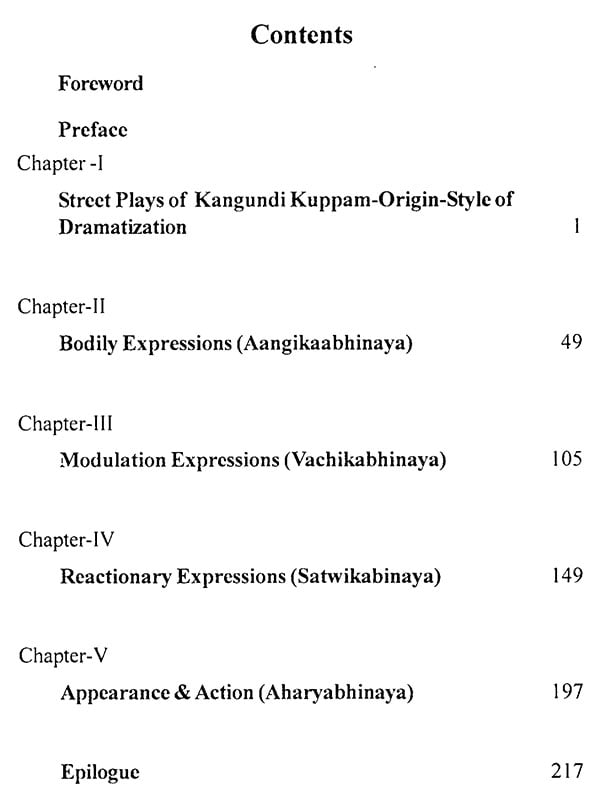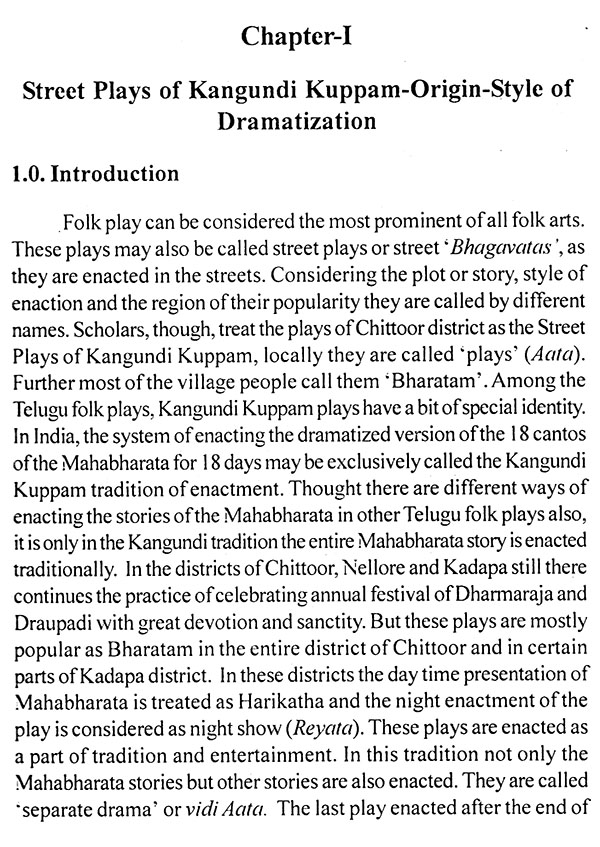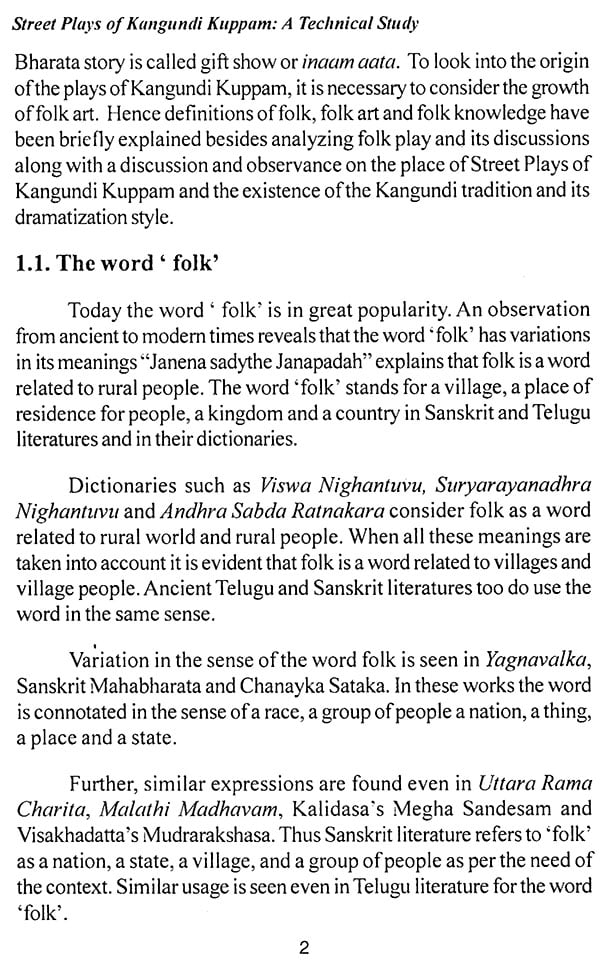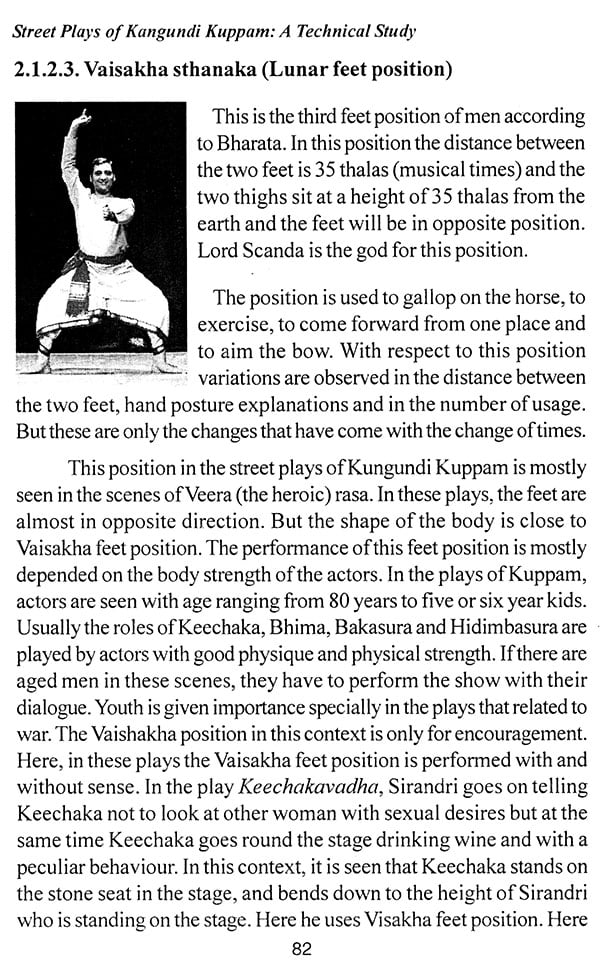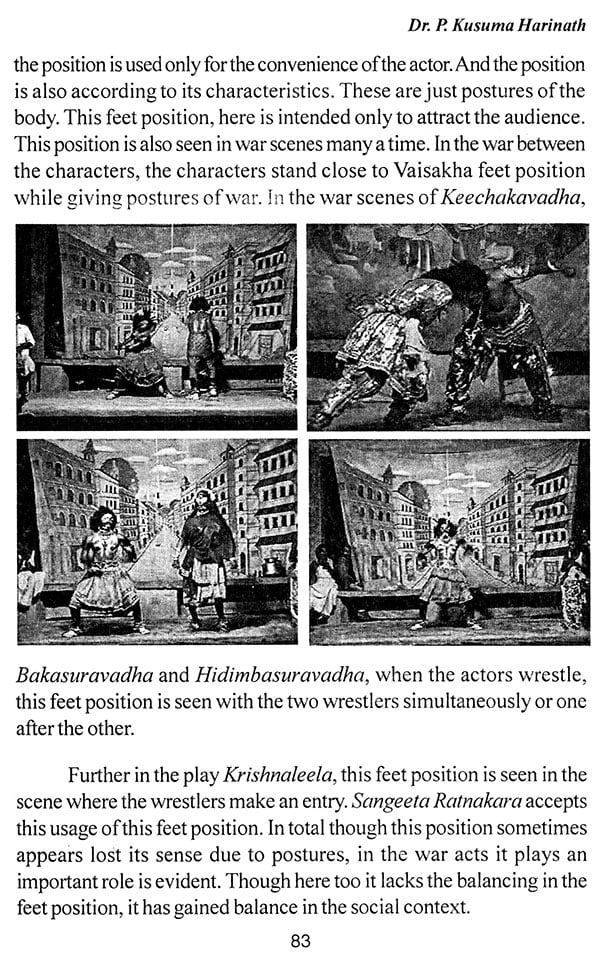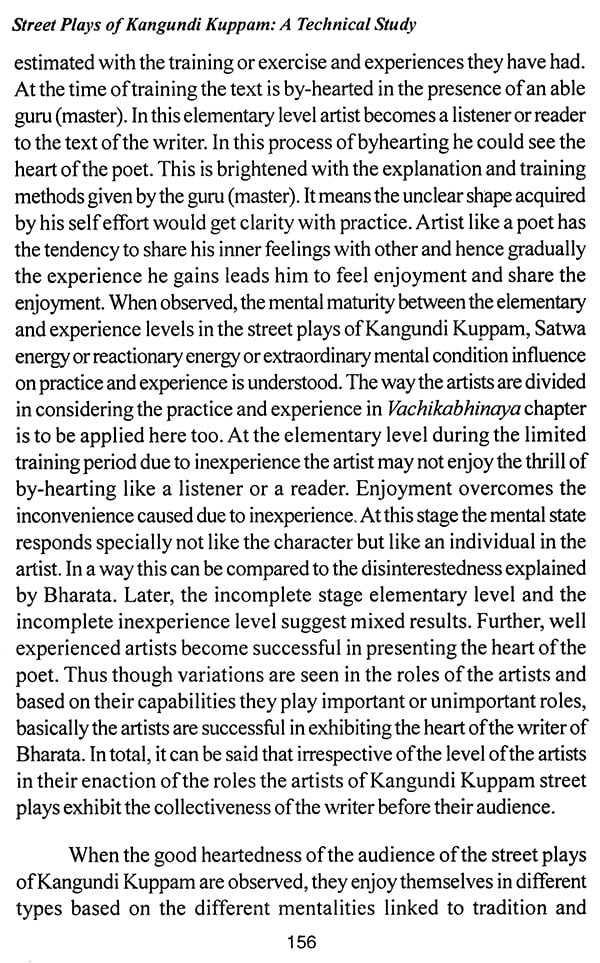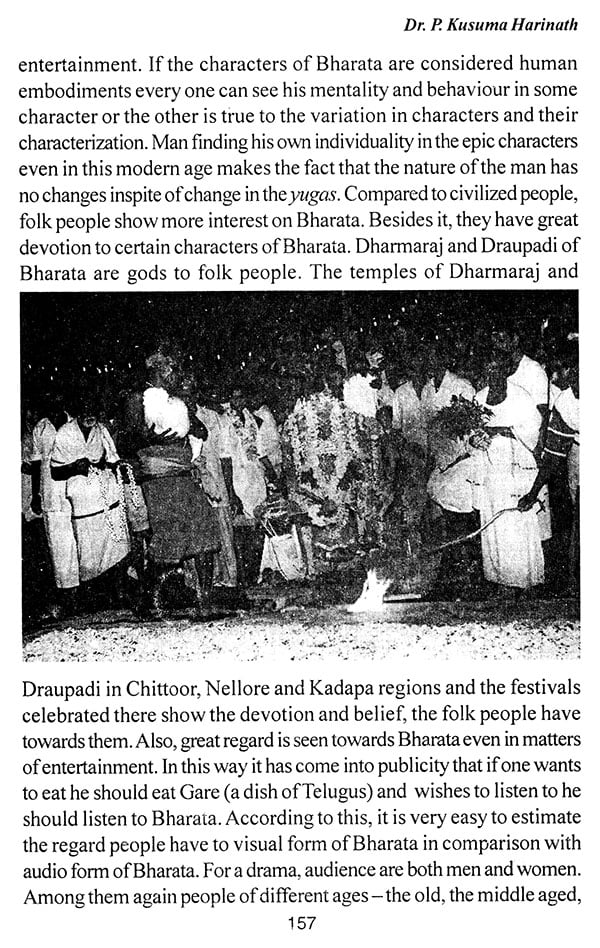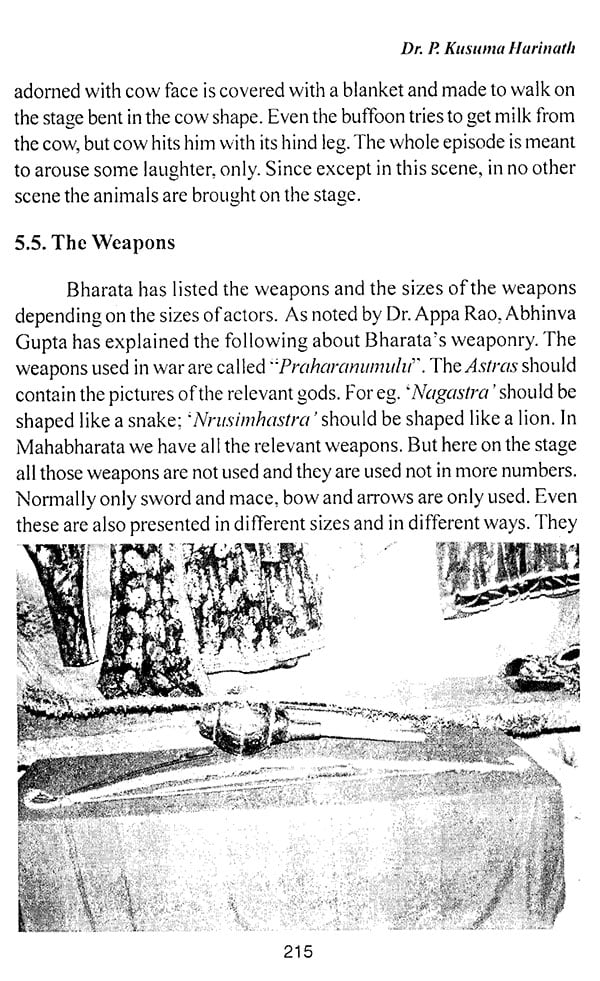
Street Plays of Kungundi Kuppam: A Technical Study
Book Specification
| Item Code: | NAX125 |
| Author: | R. Vasudev Singh and P. Kusuma Harinath |
| Publisher: | Dravidian University Campus |
| Language: | English |
| Edition: | 2011 |
| ISBN: | 9789381112250 |
| Pages: | 234 (Throughout B/W Illustrations) |
| Cover: | PAPERBACK |
| Other Details | 9.00 X 6.00 inch |
| Weight | 270 gm |
Book Description
Dr. Vasudev Singh M.A., MLPhiL, Ph.D., is scholar of out standing merit throughout his career. He was awarded Gold Medal for his Doctorate research work and also awarded Senior research fellowship from Ministry of Culture, Government of India. His present occupation is Choreography. He present many research paper in National and International seminars. Many of his articles on Arts were published in different Journals and Magazines. Scholastic View of Compiling Arts lead to foor Publications.
Dravidian University was established in 1997 to mirror the real and rich picture of Dravidian culture not only in its linguistic, litracy,culture and philosophical faces but in science and technological angles also.
The sprit of integration is the guiding force behind the creation of the University. The linguistic and cultural integration, not only at the regional but also at the national level is the cherished objective of the University.
The Government of Andhra Pradesh started Dravidian University, with the co-operation of the sister states, to reach and research and reflect on the inherent oneness of the cultures of Dravidian family of the four States whose languages number up to 27. Its endeavour 1s to promote unity and amity in the family of several languages. The main objectives of Dravidian University are to augment the common weal and social well being of the communities of marginal languages and to built bridges among the Southern states. While working on each language separately in varied areas, it aims at synthesis and a discovery of the common heritage through Comparative Studies.
The street plays of Kangundi Kuppam, locally popular as Aata have a special place and identity in the Telugu Folk Arts. The 18 parvas of Mahabharata are being performed in this region at the rate of one each a day. It is not just entertaining but has gradually gained the status of a tradition. These plays are enacted with devotion besides entertainment. The striking aspect is the division of the plays into 18 acts just as 18 parvas of the epic.
These plays are not just limited to performance and pleasure. They imbibe many customs and traditions of the region in performance. Due to this reason only, they are traditionally performed and have become popular. Also, these plays are performed differently from other plays. This kind of beliefs make the people identify themselves with the characters of the play. For these people, it is not just an art, a tradition but a part of their life without which they forget their own identity.
This book is the best example that covers all the aspects ofactions given by Bharata and other pandits. The author is to be praised for the research study he made on the Street Plays of Kangundi Kuppam linking with apt discussions given by the critics and pandits. Bharata, though framed a technical wheel for arts, he never ignored the value of worldly affairs which did have a place in his technical study. Kangundi Kuppam Street Plays are not an exemption to his technicalities.
Today, many attractive visual media have come into existence. In this current, there is every danger to traditional and hereditary aspects like these plays. In this crucial time, doing research on these aspects in a great effort. To a study like this, interest, enthusiasm and ambition are essentials. Vasudev Singh has all these qualities and so the study has gained success. This study brings a recognition to the local arts and the credit of bringing this recognition is with the author, Dr. Vasudev Singh to whom I extend my heart felt wishes.
To facilitate the Kannada readers to know of these plays, Dr.Akrasali Rushabendrachar translated this great work into Kannada. Further, to show the greatness of Telugu specially the tradition of the Kangundi plays to the world, Dr. Paradarami Kusuma Harinath has made its English Translation. I thank them on behalf of Dravidian University, Kuppam.
Folk play is considered as the most prominent art form among all folk art forms. Among all folk arts folk play is given a special and noble place. Drama is a collective art form is the word of elders. Ina folk play it is possible to see life of the folk besides music and dance. It has no rules and regulations. It has unlimited freedom with a message and entertainment. These are basically called Street Bhagavatas, Street Plays and Yakshaganas. Depending on the story, caste of the artists, place and performance style these plays are popular with different names. The present research aspect, the folk play of Chittoor district is called by scholars as Street Play of Kangundi Kuppam but locally it is popular as Aata (play) and Bharatam Aata (Bharatam play). When compared this Kangundi Kuppam play with other plays it has certain credentials. No other drama tradition has the practice of performing Mahabharata as 18 plays. Usually art forms, due to the change of times go beyond the traditional scope and become entertainment oriented but in the case of Kangundi Kuppam play it has a reverse way. They are at the beginning entertainment oriented and later has become a part of the tradition.At the beginning these plays are limited to the artists of Kangundi but later on ithas spread to the entire district and due to the influence of Bharatam . Kangundi art has gained the impression that it isa Bharata play. Today these artists , though reside in the vicinity of Kuppam like Kothaindlu and Animiganipalle , act as teachers and grand teachers to the members of the drama troupes in the entire district. Also in every troupe there is the representation of Kangundi artists. Just like the way Kuchipudi dance gained reputation all over the world which was related to Kuchipudi Agrahara village once, Kangundi tradition became a name for Bharata plays all over the Chittoor district. The talent of these artists is appreciable for their performance of it with limited artists and sources. Observing this entertaining play in the context of scientific way becomes the technical study which is the scope of this research. The research has consulted the sastras of stylists like Bharata and explains, the performances coordinating the technical and worldly aspects. Due to this research the technicalities in folk plays and world stance in sastras are understood besides getting an opportunity to know various aspects of daily life. With this motive, field trip as the main source places like Veduru Kuppam, Pachikapallam, Jakkadona, Karvetinagaram etc in Chittoor district are visited at the time of Bharata festivals. As a part of the field trip interviews are conducted with the artists and the local people and special scenes are witnessed at the time of the performances of the play. Video recording of the performance aspects of three drama troupes is also made. Among these troupes the main troupe consists of artists like Kuppam Ramachandraiah, his brother in-law Narayana Swamy, his son Neerajakshulu, his disciple Mohan Naidu etc played performance is mainly considered. Besides this, other troupes performances are observed and for the research convenience the whole matter is divided into 5 chapters and incorporated photographs wherever possible and relevant.
The first chapter deals with the origin of the Street Plays of Kangundi Kuppam method of performance, the divisions of folklore knowledge, folk arts, touching folkskits that give birth to Skits (rupakas). The theories of Skit origin are also presented. The existence of Kangundi Kuppam play, the history of Kangundi zamindars and the origin and growth of street plays are observed. The important performances with the entry of characters are discussed besides explaining the traditional scenes of Kangundi Kuppam Street Plays such as Bandi kumbham (cartload food), Thapassu (meditation), Gograhana the slaying Ilavantha and Duryodhana are considered.
The second chapter deals with Bodily Expressions with an introduction on the related aspects such as Hand expressions, Positions and movements. Various aspects of the street plays of Kangundi Kuppam such as flag, Karatharimukha, Musti, Sikhara, Suchimukha, Padmakosa, Sarpasira, Alapallava, Chaturahastha etc are discussed in view of stylists like Bharata and of worldly vision.
The third chapter discusses linguistic expressions with modulations, figures of speech and other variations of speech. The fourth chapter Reactionary Expressions deal the psychological states of the poet and the spectator discussing the aspects such as the themes, artists and scope of the audience in Kangundi Kuppam plays. Rasas like the erotic, the comic, the pathetic, the furious, and the heroic are discussed in relation with Kangundi Kuppam plays.
The fifth chapter discuses the appearance and action variations in the plays of Kangundi Kuppam Ornament decoration, Head decoration etc are discussed.
